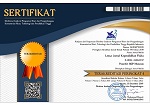PEMBELAJARAN GUIDED DISCOVERY DALAM UPAYA REMEDIASI MISKONSEPSI MATERI LISTRIK DINAMIS CALON GURU
Abstract
This study aims to remediate student misconceptions on dynamic electrical materials. Remediation activities are conducted in two stages. First, the development of guided discovery learning devices and misconception diagnostic test instruments. The development follows the 4-D model stage. The second phase is, the implementation of learning in 35 students of Physics Education in 2011 State University of Surabaya through Design One Group Pretest-Posttest Design. Student misconceptions data were analyzed by CRI analysis and learning implementation data were analyzed by mean of stepping. The data of the research shows that the average value of learning is 3.6 (very good category). Initial misconception profiles are found on every concept before learning and decline after remediation. At the drift speed concept, students experienced misconceptions 66% and 31% after application. In the concept of 'Ohm's law' 26% to 3%, source voltage parallel series strewed 71% to 43%, current consumption model 63% to 46%, series and parallel impact on power 80% to 46%, energy on battery 40% to 37%, electrical circuit typology 69% to 51%, electric power in mixed circuit 51% to 17%, current on a circuit 40% to 11%, potential difference between two points 43% to 9%, use of measuring instrument electricity (ampermeter and voltmeter) in the series 37% to 26%, and Kirchhoff rules 20% to 26%. The results of this data analysis can be concluded that the learning tools developed can reduce student misconception.
Keywords
Full Text:
PDFReferences
Berg, E.v.D.. 1991. Miskonsepsi Fisika dan Remidiasi. Salatiga: Universitas Kristen Satya Wacana
Carin, A.A. 1993. Teaching Science Through Discoverry. Canada: MacMillan Publising Company
Duch, J. B. 1995. Problems: A Key Factor in PBL. [Online]. Tersedia : http://www.udel.edu/pbl/cte/spr96-phys.html. (15 November 2013)
Giancoli, D.C. 2009. Physich for Scientists & Engineers with Modern Physics.New Jersey: Pearson Prentice Hall
Hasan, S., Diola B, dan Ella L. K. 1999. Misconception and the Certainty of Response Index (CRI). Journal: Physics Education, Vol. 34 No. 5 hal. 294-299
Halliday, Risnick, and Walker,J. 2009. Fundamentals of Physics 8th Edition. John Wiley & Sons Inc
Major, Claire,H.,andPalmer, B.. 2001. Assessing the Effectiveness of Problem Based Learning in Higher Education: Lessons from the Literature. [Online]. Tersedia : www.rapidintellect.com/AE Qweb/mop4spr01.htm (15 November 2011)
Pujayanto. 2012. Miskonsepsi IPA (Fisika) pada Guru SD. (Online), Universitas Negeri Solo, Vol.1 (1).
Suparno, P.. 1997. Filsafat Kontruktivisme dalam Pendidikan. Yogyakarta: Kanisius
Suparno, P.. 2005. Miskonsepsi dan Perubahan Konsep Pendidikan Fisika. Jakarta :Grasindo
Roselizawati, Sarwadi, dan Masitah Shahrill .2014.Understanding Students' Mathematical Errors and Misconceptions: The Case of Year 11 Repeating Students.Article: MathematicsEducation Trends and Research/http://www.ispacs.com/journals /metr/2014/metr-00051 /
Thiagarajan, S., Semmel.S., and Semmel, I.M. .1974. Instructional Devalopment for Training Teachers of Exceptional Children A Sourcebook. Indiana: Indiana University.
Tipler, P., and Mosca G. 1997. Physics for Scientists and Engineers. Berkeley: Cherry Hill
USAID. 2006. Science and Thechnology in International development. Washington, D.S.: National Academies Pres
Woolfolk, Anita. 2009. Educational Psycology Active Learning Edition. Boston: Pearson Education, Inc.
Zero, D. 2011. Thinking Critically and Resolving Misconceptions: https://sites.google.com/site/dmzeroproject/Home/critical-thinking-and-misconceptions: 17 Januari 2012
DOI: https://doi.org/10.33394/j-lkf.v3i1.378
Refbacks
- There are currently no refbacks.

Lensa: Jurnal Kependidikan Fisika is licensed under a Creative Commons Attribution-ShareAlike 4.0 International License.


.png)